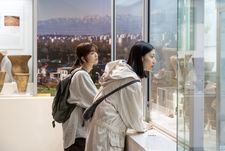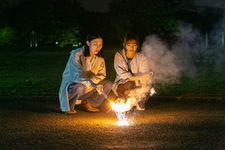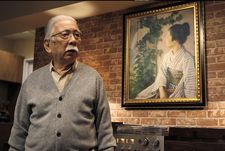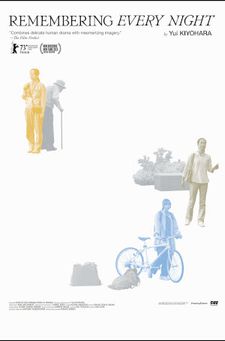 |
| Yui Kiyohara with Anne-Katrin Titze on Tadashi Okuno and Abbas Kiarostami: “I did cast Mr. Okuno because I saw Like Someone In Love and he was fantastic.” |
“It’s missing a key” is the first sentence spoken by one of the musicians whose compositions will accompany Yui Kiyohara’s beautifully memorable Remembering Every Night (Subete No Yoru Wo Omoidasu, a 2023 New Directors/New Films highlight), shot by Yukiko Iioka (cinematographer of the Silver Bear Grand Jury Prize winner, Ryûsuke Hamaguchi’s Wheel Of Fortune And Fantasy at the 71st Berlin International Film Festival), stars Kumi Hyodo, Minami Ohba, and Ai Mikami with Guama Uchida, Shintaro Yuya, Mizuho Nojima, and Tadashi Okuno (star of Abbas Kiarostami’s Like Someone In Love).
 |
| Sanae (Minami Ohba) with Mr. Takada (Tadashi Okuno) |
Tama New Town is the setting, a housing complex built in 1971 as a Tokyo satellite city. This is where the film lets us stroll around and bike with its three female protagonists. Via these movements and the caring gaze the ordinary becomes extraordinary. Chizu (Kumi Hyodo) is 44 and recently lost her job as a kimono dresser. This day in May, when the action of the film takes place, is her birthday.
Sanae (Minami Ohba) at age 33 is a gas meter reader, who is gifted mandarins by a woman who tells her about the history of Tama New Town and the fact that women in the past had organised a vibrant community there to bring up their children in harmony and togetherness. Sanae subsequently is the one who accompanies an older gentleman, Mr. Takada (Tadashi Okuno), whose dementia makes him go back to a place where he doesn’t live anymore, to safety.
The third protagonist is Natsu (Ai Mikami), a student of 22, who lost a dear friend precisely a year ago. We first see her dancing in the park, while Chizo, from a distance mimics her movements. Together with her girlfriend Fumi (Guama Uchida), Natsu visits an exhibition on the Jōmon era, Japan’s Neolithic period and later that night, lights sparklers to celebrate the memory of their school friend, whose last photos were being developed by the boyfriend of Sanae, protagonist # 2.
From Tokyo, Yui Kiyohara joined me on Zoom for an in-depth conversation on Remembering Every Night.
Anne-Katrin Titze: Congratulations on a beautiful film!
 |
| Chizu (Kumi Hyodo) with children |
Yui Kiyohara: Thank you!
AKT: Where are you?
YK: I am in Tokyo.
AKT: I want to start with the very strong sense of place. It feels as though we are there, even if we’ve never been to Tama New Town, we feel we know it. There is also the feeling of something lost, as if we were also conjuring up ghosts. It’s the present and the past for you?
YK: Yes, Tama New Town is the town that I grew up in as a child, so it’s a place of origin for me. It holds a very important meaning for me in my life. Tama New Town is an artificially developed place. The architects and city planners just planned it without regard to how people are going to inhabit it. It was very top-down, you know, a very artificial type of place.
That was 50 years ago and people have lived there and the way they did changed. The way of life was forced on them then, but then people have adapted their lives and moulded them around Tama New Town. I really enjoy seeing that process of change, of transformation it went through.
AKT: It is felt in the film in subtle ways.
 |
| Natsu (Ai Mikami) with Fumi (Guama Uchida) |
YK: You mentioned the feeling of loss. This town was created for 50 years by people who lived there. Now the people who lived there are starting to be elderly. People are less active in the community. To make this film I interviewed people who were living there since the Seventies or Eighties. When they moved in, infrastructure within Tama New Town wasn’t enough, so they needed to come together to supplement what they didn’t have.
Women were the driving force of that community, so they had connections within Tama New Town, but now over the years this tight-knit community is lost because everybody is leaving or elderly. People need to look outside for jobs and individuals living in that community are starting to get separated from the community and I wanted to express that passage of time in the film.
AKT: You have a beautiful shot early on of the window and a glass measuring cup at the home of your first protagonist and we see the cars driving down below on the street. And I thought - why do I know this setup somehow? Later when Mr. Takada comes in and he is played by Tadashi Okuno, I realised that I know this shot [and the actor] because of Abbas Kiarostami’s Like Someone In Love! Is there a reference to Kiarostami’s film?
YK: Now that you mention it, I totally see the connection and similarity! But that was not my intention. As you said, in Like Someone In Love windows are a very important feature and motif in that film. I chose that window shot because in complexes like Tama New Town, the windows are very striking because they all look the same but if you think about it, the room inside and the view from that window is going to be all different.
 |
| We see different birthday parties with strawberry cream cakes and baumkuchen. Photo: Anne-Katrin Titze |
That really struck me as I was walking around the apartment complexes around there and that’s why I wanted to have an impactful shot out the window. But I did cast Mr. Okuno because I saw Like Someone In Love and he was fantastic.
AKT: Absolutely, I agree. A film that came to mind a few times while watching yours - very different, but maybe because of the wanderings in the park and a sense of mystery, was Antonioni’s Blow Up. Is Antonioni someone you like and what are some other filmmakers whose work you feel affinity towards?
YK: There is no film or director that I referenced with this movie, but obviously Blow Up is one of my favourite films. One of the film directors that I really like is Apichatpong Weerasethakul, the Thai film director. He deals with how the time connects from past to present. He deals with memory of people who are gone, etc.. Those are the things I really enjoy and relate to.
AKT: I see the connection to Weerasethakul, now that you mention it, in the context of storytelling. The presence of the past, the spells, the cats. I loved the moment later on in the film when we see all the footage of different birthday parties with strawberry cream cakes and baumkuchen. In this context a central question comes up: Transferring from analogue to digital. The second protagonist [Sanae] asks “What is actually being changed?” I felt this question about change is central to the entire movie, isn’t it?
 |
| Fumi (Guama Uchida) and Natsu (Ai Mikami) with sparklers |
YK: Technically speaking, those birthday footage videos are captured on video to Mini DV. Film is definitely analogue, but I consider mini DV a part of the digital era already. Rather than posing the question analogue to digital, my central question and message is more: What is memory? Whether it be analogue, digital media or just human brains.
You know, memory exists somewhere, right? And there is some mystery to it. Even though people forget memories, the memory remains somewhere. Whether it be on a digital video tape or even if that is lost, I feel like memory exists somewhere and there’s something mystical about it. That was kind of my central idea for the whole film.
AKT: You even go back to the clay figures with the “ancient garbage exhibition” that asks the question what remains of us and world memory. You and your cinematographer Yukiko Iioka, whom I believe I know from Ryûsuke Hamaguchi’s film Wheel of Fortune and Fantasy, give us the luxury of time. We get time to really observe, which is a great gift you give us. Please talk a bit about your collaboration with your cinematographer!
YK: Yes, Yukiko Iioka is a fantastic talent. She’s worked with director Hamaguchi and others. When we took a walk together in Tama New Town to location scout, she took photos and in the photos that she captured I really felt that there is a passage of time. She really captured the time that flows in that space. As a camera person she doesn’t try in the process of shooting to capture the fictional story that we are trying to create in the film.
 |
| Tadashi Okuno in Abbas Kiarostami’s Like Someone In Love |
She is there to sort of document what unfolds in front of her and is trying to record what is happening in front of her. I felt that attitude is really what we needed for this film. The slow rhythm is intentional but we didn’t set out to make a slow film. It’s just when I try to adapt her point of view that I am going to document and record what is unfolding in front of us, then it just ended up being that slow rhythm.
AKT: The first sentence we hear in the film, at least according to the subtitles, is “It’s missing a key” said by the musicians. Which is lovely, because this missing key is everywhere, is the memory maybe. The musicians, whose music we hear throughout the film, and this is so lovely, prepare us in a way for everything that is happening afterwards.
They talk about starting in the middle and also that the bags and the jackets match of two people walking away. So we look at the clothing, for instance how the colours go together when the gas meter reader is walking with the older gentleman who is lost. So there’s a lot of exposition in a beautiful, playful way in that scene with the musicians!
YK: Thank you so much for the wonderful comment! What’s interesting about that scene is that those people who are in the first shot are the band members who created the background music. They are not actors, they are musicians and I wanted them to be in the film because I consider the music for this film to be not something to create emotional dynamics for the viewers. But the sound exists in this film as just another character.
 |
| Remembering Every Night poster |
I wanted the people who make those sounds to be another resident of that town and the sound they create to exist in that town as well. That scene is kind of unscripted. There’s a flow that I gave them, but all the lines are unscripted and improv. I’m really happy that you saw connections to what is happening later in the film. It’s accidental but I’m so happy to hear that you were able to make that connection and that’s wonderful, thank you!
AKT: It’s beautiful. Are you working on a new film?
YK: I’m currently not working on anything right now. It’s because after I made this film I worked on another film and I just finished the project. It’s based on a story about my grandmother and it’s in-between documentary and fiction.
AKT: Looking forward to it. Thank you for this!
YK: Thank you so much!
Remembering Every Night opens at Film at Lincoln Center on Friday, September 15. Yui Kiyohara’s debut feature, Our House (Watashitachi no ie) will also be screening. Buy a ticket to one film, get a ticket to the other free.





















